Table of Contents
Visit Montessori Pulse TPT Sale
Phonics is learning the sounds of the letters. The Montessori Phonics curriculum is one of the most effective ways to teach reading to preschoolers. The sounds prepare the way for language development. They build a foundation for reading and writing.
Nursery rhymes, storytelling, and simple sound games are techniques to introduce sounds. Talk about different sounds you hear during the day with your child. Bringing the child’s attention to the Beginning, Middle, and Ending sounds of words is the first step. The next step is to introduce Sandpaper Letters to teach the “graphic codes” of the sounds.
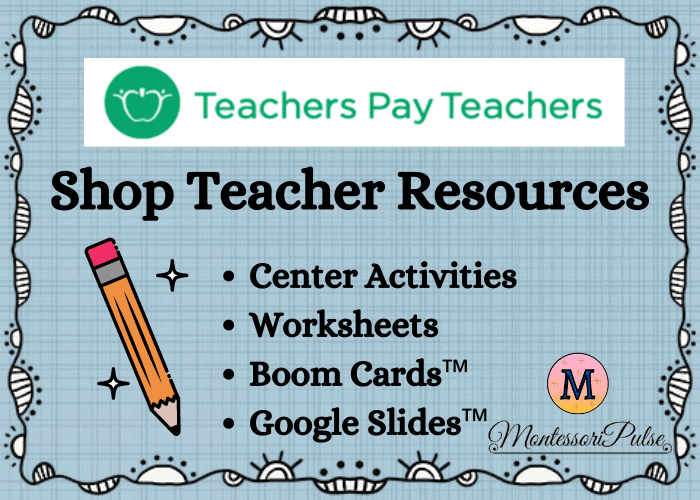
Free Sandpaper Letter & Number Printables
[mailpoet_form id=”19″]
Montessori phonics activities for preschool
- Sandpaper Letters
- Sand Tray
- Movable Alphabet
- Language Mat
- Sound Card and Object/Picture Cards
These Montessori Materials are simple but effective. These few materials can go a long way and will take months for the child to master these. It is important to give the child enough time and space to practice. Daily practice and repetition help internalize the sounds.
Check out my last blog post: How to DIY Basic Montessori Materials
Teaching Phonics Step by Step
Sandpaper Letters
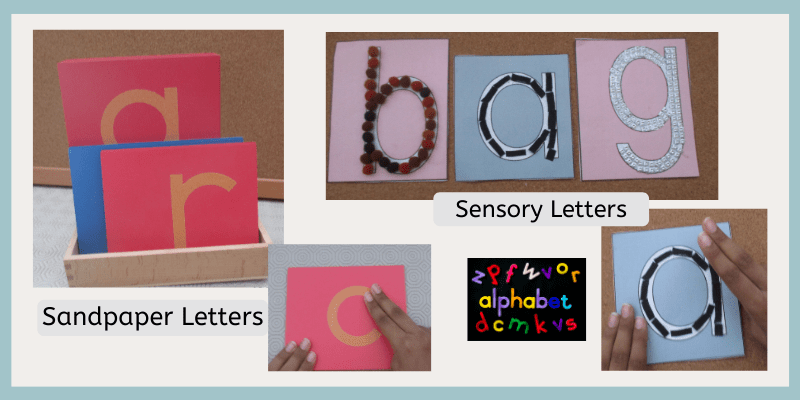
Sandpaper Letters give a concrete touch to the letters. They build muscle memory and prepare the child for both writing and reading. When introducing phonics, we do not have to follow the alphabetical order. choose any 3 sounds that you prefer. But if it is the child’s first time or depending on the child’s fine motor skills, you might want to choose easy shapes like “l”. It is best if the letters are contrasting in shape and you include at least one vowel. I always start with “l”, “c” and “a”.
The Three Period Lesson: 3 Easy Steps
- Naming
- Recognition
- Remembering
Naming
Turn the three chosen Sandpapers letters upside down. Pick the one you want to teach first while the rest of the two are still facing down. Trace (with two fingers: index+middle) and name the Sound (not the name of the letter). Give the child a turn each time. Repeat for all three Sounds. (Make sure all the other letters are facing down when you present one.)
Recognition
Turn all three letters over and display them in front of the child. The child should be able to see all three letters at the same time. Ask the child, “show me l”, “show me c”…etc., or “point to c”, “could you trace a”…etc. Do not ask, “what is this sound?” Make sure your question includes the name of the sound. Because at this stage it is too early for the child to remember the new sounds by themselves. Repeat many times until you feel that the child is ready for the next level.
Remembering
This stage is like a testing stage. Turn all three letters upside down like the first stage. Take one letter at a time and ask, “what sound is this?” If the child can tell, then move on to the next letter. If you feel like the child needs more practice, you can always go a step back and practice the previous stage. In the Montessori method, this method of teaching is called “ The Three Period Lesson”. It is a very effective strategy to teach new words. Repeat these stages until you cover the whole alphabet.
Sand Tray
Sand tray is the child’s first writing experience. Writing on the sand tray is a good way to further practice the sounds. We can let the child use both Sandpaper letters and the sand tray simultaneously. Show the child how to trace the Sandpaper letter first and write the same letter on the sand. For this activity, you can add Picture cards as well. Try to bring the child’s attention to the beginning sounds of the letters. This is an extra step and you can decide if the child can process all three actions together. If the child needs extra practice for writing on the sand, you can leave this step out.
Movable Alphabet + Language Mat
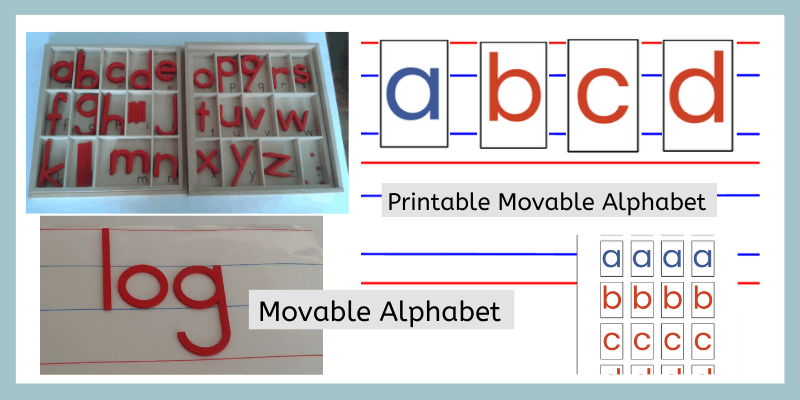
These letters are a little abstract compared to Sandpaper Letters. When the child has learned at least 4-5 sounds you can introduce this activity. The purpose of the Language Mat is to familiarise the child with the position of the letters on the lines.
Steps
- Bring the Moving Alphabet and the Language Mat to the table. (The real Montessori Movable Alphabet is too big to keep on the table. So you can keep it on the shelf or a Mat.
- Ask the child to find the particular sounds and show him how to place them on the mat.
- Let the child repeat over and over again.
Movable Alphabet + Language Mat + Objects / Picture Cards
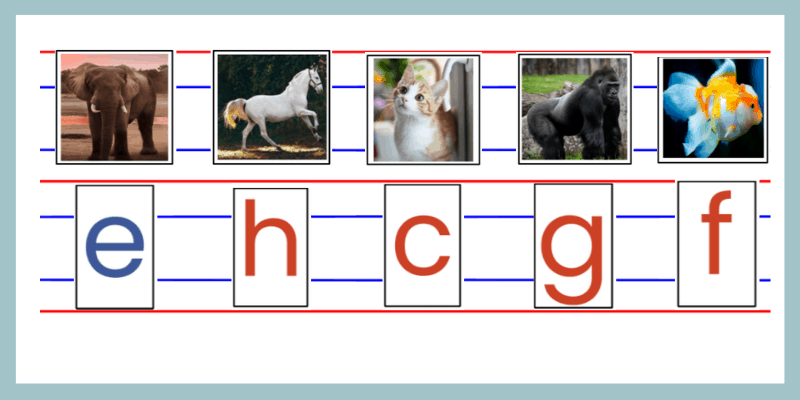
The purpose of this activity is to bring the child’s attention to the beginning sound of words. By now the child should be quite familiar with sounds and their position in the box.
- Show the Object or the Picture first and ask the child which sound he/she hears when you say that word. For example, “What is the first sound you hear when you say cat?”.
- Ask the child to find that sound from the Alphabet Box and place it on the mat next to the Object or Picture Cards
- Keep the activity available on the shelf for the child to practice daily. You can even improvise different ways to do this to make it more fun and exciting. Distance Pairing is one way you can spice up this activity.
Distance Pairing:
Distance Pairing is a matching activity. The difference is we keep the matching objects far away from each other. For this activity, keep the letters on one table and the Picture Cards on a table across the room. Give the child one picture at a time to go over to the table across the room and bring the beginning. This is a brilliant way to get the child engaged in the activity and be active. Preschool-aged children are Sensitive to movement. Distance Pairing can get the child to move while engaging in meaningful activity.
Sound Cards and Objects/Picture Cards
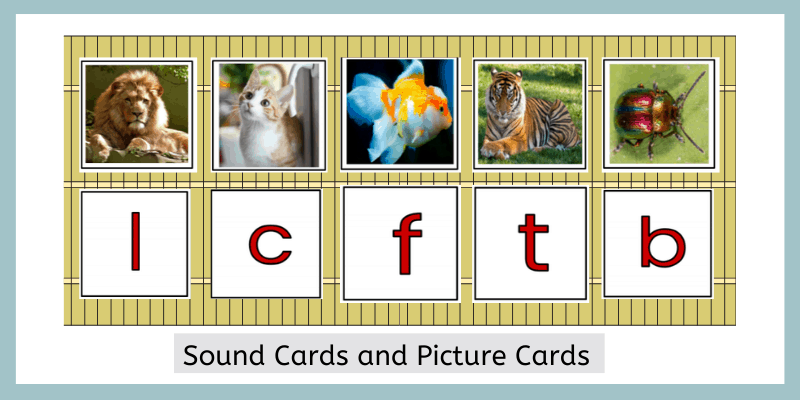
For this activity, we will be using the same Objects/Picture cards as before. But the sound cards are a little different than the Movable Alphabet. The real Montessori Movable Alphabet is wooden letter cut-outs. They give the child a more concrete touch. Sound Cards are abstract compared to the Movable Alphabet. Make Small boxes that consist of 6 Sound Cards and 6 corresponding Picture cards each. Keep them on the shelf for the child to practice. This is a great language center activity. You can also do Distance Pairing with this activity. The method is the same. Replace the Movable Alphabet with the Sound Cards and spread it on a table across the room. Give the child enough time and space to practice and learn. Always observe and decide when to move on to the next level.
Importance of Phonemic Awareness at an early age.
A child’s language development starts right at birth. Every child goes through a Sensitive Period for Language till about the age of 6. During this period, they can learn as many languages as they are exposed to. Learning the mother tongue to perfection is effortless. Children learn the accurate use of vocabulary, grammar, and intrinsic syntax perfectly. This is the reason why any child will learn spoken language even if they are not taught. But it is not the same when it comes to writing and reading. Writing and reading need to be taught, strategically. The first step to successful writing and reading is phonemic awareness. It’s crucial to introduce phonic activities while they are sensitive to language. (birth to 6 years). Once the child passes this period it will take extra effort for the child to learn them.
Conclusion
Use the Sandpaper Letters to introduce the sound. Take Three sounds at a time and follow the Three Period Lesson. Then bring the Sand Tray right away. Once the child knows about 3-4 sounds introduce them to the Movable Alphabet and Language Mat. Keep Sound Cards and Picture Cards available on the shelf for the child to practice daily. Remember to observe and follow the child to decide how to pace these activities.
